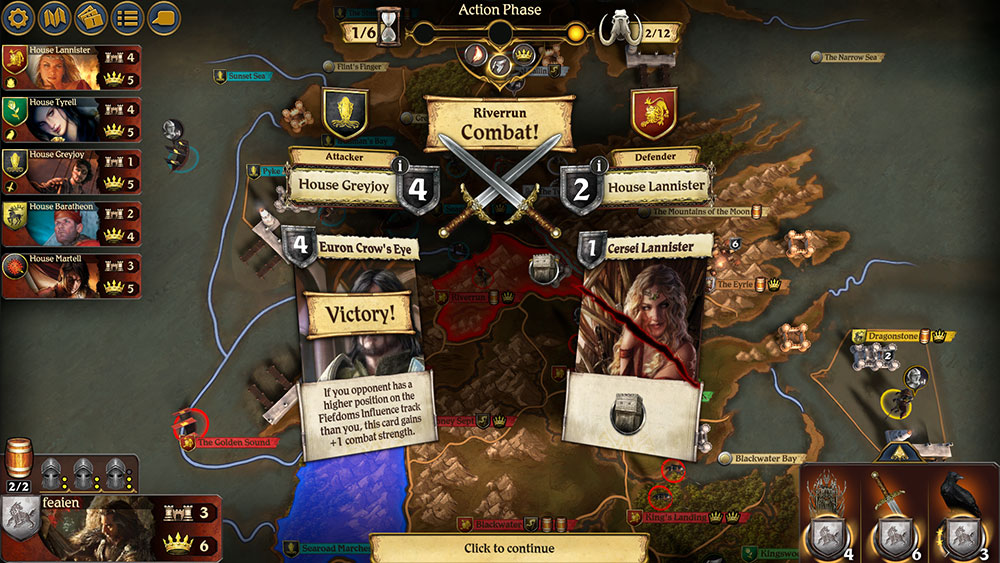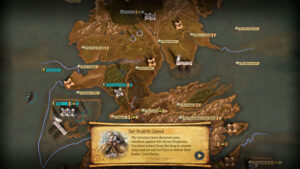 I’m a big fan of the world of A Game of Thrones and admittedly am captivated by anything with its IP (e.g. I’m guilty of owning Risk: Game of Thrones) so when we were offered to review the digital version of A Game of Thrones: The Board Game, I jumped right on it.
I’m a big fan of the world of A Game of Thrones and admittedly am captivated by anything with its IP (e.g. I’m guilty of owning Risk: Game of Thrones) so when we were offered to review the digital version of A Game of Thrones: The Board Game, I jumped right on it.
Something I need to note right away as it will influence how I approach this review is that I have not had experience playing A Game of Thrones: The Board Game on the tabletop. I learned everything I know about the game with the digital version, so some issues I ran into may not apply to you if you have previous experience with the tabletop version.
It’s a strategy game for 3-6 players that takes about 2 hours to play. The best experience is with 5 players for more chaos and more chances at turning things around in your favor without the pressure of alliances.
Gameplay Overview:
In A Game of Thrones: The Board Game, players each control one of six Houses. As you lead the House, you’ll muster armies, conquer territory, and form alliances to control the most Castles and Strongholds by the end of the 10th game round.
At the start of the game, each House has a unique position on three different Influence tracks: The Iron Throne, the Fiefdoms, and the King’s Court. Turn order is determined by the Iron Throne and the player in position 1 of this track decides the outcome of all non-combat ties. Combat ties are broken by the Fiefdoms track and the player in position 1 of this track may grant themselves a +1 combat strength bonus once per game round. The number of Special Orders available to a House during the Planning Phase is determined by the King’s Court track and the player in position 1 of this track can perform bonus actions at the end of every Assign Orders step.

A Game Round consists of three phases: The Westeros Phase, The Planning Phase, and the Action Phase. The Westeros Phase has three different decks, and the top card of each deck is drawn to establish new game procedures and events for the round. It also determines the strength of the Wildlings, ultimately leading to a Wildling attack. The Planning Phase impacts each area containing one or more units of a House, where Orders are assigned facedown by the governing player. Finally, the Action Phase is when orders from the Planning Phase are resolved and executed.
There are five different types of Orders: March, Raid, Defense, Support, and Consolidate Power. March Orders represent the movement of troops and ships across land and sea. Raid Orders remove one adjacent enemy Support, Consolidate Power, or Raid Order. This can disrupt enemy plans and resources. Defense Orders grant a Combat Strength bonus to the defender of the assigned area. Support Orders provide assistance to forces engaged in a nearby battle, and one of two participants in adjacent combat is chosen to support. Finally, Consolidate Power is a direct way for players to gain Power from an area they control. During the Action Phase, the order of resolution is Raid Orders, March Orders, then Consolidate Power Orders.

Of course, the most dynamic aspect of this game is Combat, and a player’s Combat Strength is determined by the units in combat, any supporting units, defense order (for defender), march order (for attacker), Valyrian Steel Blade ability, House cards used, and garrisons (for defender). Attacker and defender compare strengths after all of that are counted, and the victor is the player with the highest strength value.
Another unique aspect of this game is the use of ships to transport land-based units faster than on foot. It can get a little complicated to determine adjacencies by consecutive sea areas, but this is an important part of any future defense or attack. Note that adjacency is only determined for marching and retreating, not supporting, raiding, or any other purpose. Ships can even enter into combat with adjacent sea areas so they should not be viewed only as bridges but also ways to block opponents who try to develop sea strategies.
By the end of the 10th Game Round, the player will need to control as many areas with a Castle or Stronghold as possible by having at least one Footman, Knight, or Siege Engine in the area, or by establishing control with the spending of Power. There is also a possibility to immediately win the game by controlling seven areas containing either a Castle or Stronghold.

Game Experience:
As a new player and relying entirely on the tutorial, it, unfortunately, held my hand too much and did not really give me the opportunity to grasp what I was doing. It makes it easy for you to just click wherever it’s pointing to, with the snazzy animations and exciting sounds you’ve completely just blanked on what just happened. There are three scenarios and the first two go by like a breeze. Then you get to the third one, and the tutorial completely lets your hand go and tosses you to the sharks. I cannot even begin to tell you how many times I played the first two, desperately trying to understand the meta of the game and failing miserably at the third scenario.
Therefore, I think I’m recommending this to those who have played the tabletop version already, and if you’re trying to learn for the first time, the tutorial is only good at teaching the interface but not the game. I’m much better at fully grasping a game by reading the rulebook and it took me a few clickthroughs to finally find the rulebook hidden in the settings. I’m definitely not used to looking there in other digital board game versions I’ve played but it was at least a major relief to know that they included it.

In terms of overall gameplay, this game is no joke. There’s a level of mastery that I’m hoping to gain eventually in controlling the pace of conflict. My previous, very simple “dudes on boards” experience tells me to keep mustering units, but things can change so quickly from event cards or moves made by opponents that taking too much or too little time can be detrimental. Even understanding weak or vulnerable territories to monitor the situation on has been tough because Westeros as a region has adjacencies from ports that can be hard to track. Toggling the strategic view in the game can help with this as it provides a bird’s eye view without any of the units on the board, but not by much.
There’s also no catch-up mechanism outside of beneficial event cards during the Westeros phase so it really punishes new players. There is also some insight to be gained in experiencing all the Houses as they have specific starting points and cards available to them that differentiate them from the others. With games at a high player count, it can be difficult to take down powerful alliances or change the pacing of acquisitions, so event cards that come up during the Westeros phase are helpful in providing the disruption one needs to turn around the game.

As if it wasn’t enough to just navigate Westeros, politics comes into play, and bidding crowns acquired throughout the action phase can help you take the Iron Throne, among other things that provide side benefits like breaking ties in or out of battle. Figuring out which of the tracks is most important to you at different points of the game can be something you learn over time, or at minimum, you have 10 game rounds to determine your priorities.
Because this is a digital implementation, as with all other implementations, it’s very handy that it automatically calculates the power of a region of interest. I can imagine with the analog version that it can be annoying to have to count the influence of a House in the region if they have a varied number of units there. The only downside to the digital world is that despite all the animations, they didn’t bother adding in a fast forward button if playing against A.I., so playing with full player count can take up way too much time when it’s not your turn and unnecessarily lengthen gameplay.
Arguably one of the hardest things to do in our hobby is to find other players to game with, so the online lobby and multiplayer function of the digital app is a great thing to have if you are itching to play this game but can’t seem to get a group together. I can’t speak to whether there are a lot of options on who to play with because it varies by time zone, but it seems active enough to be able to find a game to jump into if you’re patient.
Final Thoughts:
A Game of Thrones is for players looking for something more challenging than your typical “dudes on boards” tactical combat but with less of a time investment than other war games out there. If you’re just learning this game for the first time, it may be difficult to fully grasp the game from the default tutorials, so I recommend that you dig into the rules found in the Settings menu to fill in any gaps in learning.
Overall, the sound design and music are on point and if you can be patient with the number of animations happening on everyone else’s turns you can enjoy some of the dramatic moments during your own battles that you don’t get while playing on the tabletop. With the availability of the online lobby, you can look forward to more plays than you may have at the table as well.
Final Score: 3 Stars – Try your hand at controlling one of the great Houses set in the world of A Game of Thrones and conquer or be conquered in Westeros
 Hits:
Hits:
• Great soundtrack and sound effects
• Tutorial onboards you quickly
• Clean interface is easy to read
Misses:
• Animations can prolong gameplay
• Tutorial does not make strategies clear
• Rulebook is hidden in the settings
Source: Board Game Quest





